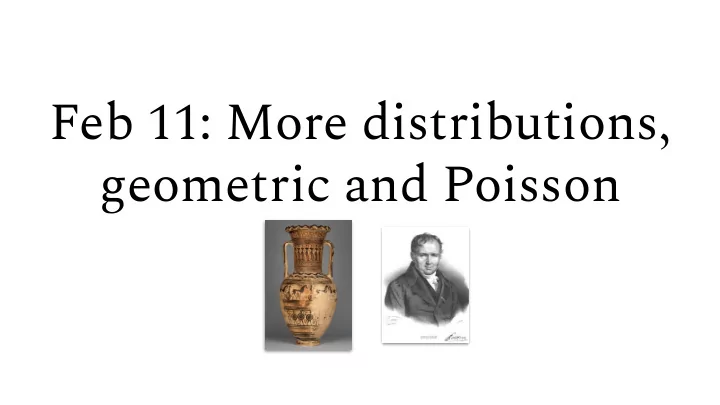

Feb 11: More distributions, geometric and Poisson
Active Learning Initiative pre-assessment What ● Online multiple choice, posted on Campuswire ○ SCIENCE! for Equivalent to one HW ○ Graded only for completion ○ Due by 6pm Friday (~15 mins) ○ Why ● We need a way to evaluate change in knowledge and confidence ○ Same problems before and afuer class ○ Implication: you almost certainly do not know how to do these problems ○ How ● If you are not sure, guess ○ Answer as much as you can, but do not read or study ○
For loops, list comprehensions, Counters for loops do operations repeatedly. They are great for operating on lists and over ranges of numbers. Nested for loops are good for iterating over all combinations of two lists. List comprehensions are Python's way to turn a list into another list. They are equivalent to starting with a new empty list and then appending something for each element of an existing list. Lists of tuples are a common python data structure. We ofuen use list comprehensions to pull out one element of each tuple. collections.Counter is a useful tool for counting things.
Assumptions make math easier One of the most common statistical assumptions about events is that they are 1. Independent (one event tells you nothing about the next) 2. Identically distributed (probability is the same for each event) If events are independent, we can simply multiply their probabilities . If they are iid , we can just find the probability of one event and raise it to an exponent .
Geometric distribution: flips before first Heads What is the set of possible events? Are these flips independent ? Are these flips identically distributed ?
Geometric distribution: flips before first Heads What is the set of possible events? Are these flips independent ? Are these flips identically distributed ? Variables Output x is # of "success" flips Parameter p is probability of one "success"
x successes, one failure Probability of one success = p
x successes, one failure Probability of one success = p P(S, S, S, S, S, F) = P(S) P(S) P(S) P(S) P(S) P(F) = P(S) 5 P(F) = p 5 (1-p)
x successes, one failure Probability of one success = p P(S, S, S, S, S, F) = P(S) P(S) P(S) P(S) P(S) P(F) = P(S) 5 P(F) = p 5 (1-p) Independent Identically distributed
Geometric distribution: good and bad ● No upper bound ● Only one parameter ( p ) ● Probability always decreases as x increases
Poisson Distribution: Events within ranges Ships arriving in Shanghai Protons hitting a sensor Croissants sold at Gimme No clear maximum, relatively constant rate
Recommend
More recommend